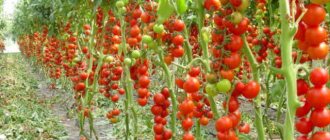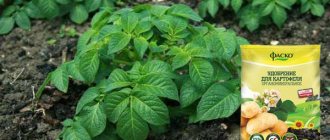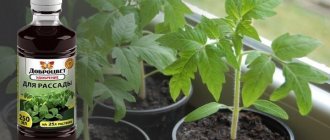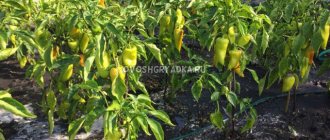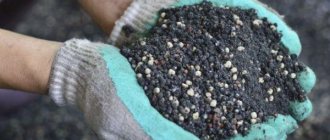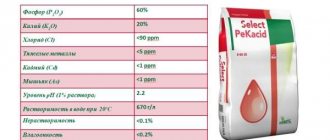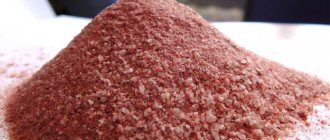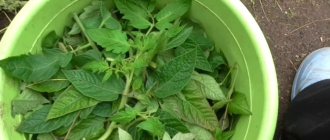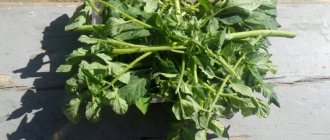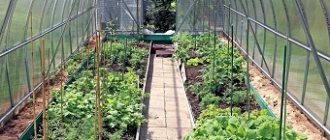Why do tomatoes need calcium?
Calcium (Ca) is an important chemical element for the development, growth, and fruiting of tomatoes. They need it at all stages of the growing season:
- At the stage of sowing and germination of seeds, calcium activates the processes of consumption of proteins contained in them, which contributes to the timely emergence of seedlings. Important! If there is a lack of calcium in the soil, the development of the root system of seedlings slows down and hairs do not grow on it.
- Calcium, together with potassium, phosphorus, and nitrogen, stimulates the development of the tomato bush, affects the appearance of ovaries and the formation of fruits.
Attention! Symptoms of calcium deficiency in tomatoes are blossom end rot, death of the growing points of the bush and its roots, falling of buds and ovaries.
The significant role of calcium is manifested in creating growing conditions favorable for tomatoes:
- this component compensates for the influence of macro- and microelements found in the soil on the growth processes of tomatoes;
- calcium normalizes nutrient metabolism in the plant;
- it helps accelerate the processes of decay of organic matter in the soil;
- this is a necessary element in acidified podzolic soils, which are characterized by an increased content of mobile forms of iron, aluminum or manganese, which have a negative effect on plant development - the element binds them into sedentary compounds that are not absorbed by tomatoes;
- calcium is involved in the processes of photosynthesis and carbohydrate transfer.
This chemical component affects the formation of tomatoes. Calcium and magnesium in plant organisms are the basis of the intercellular substance (pectin). In addition, calcium maintains the integrity of cell membranes, takes part in the formation of their walls, and increases the strength of plant tissues. It helps increase the endurance of tomatoes.
Comment! The calcium content in tomatoes is 14 mg/100 g, which corresponds to 1% of the daily requirement of this element for humans.
The benefits of calcium nitrate
The drug is ideal for tilling the soil before sowing and its use will have a beneficial effect on the development of seedlings. It will create a highly nutritious environment for vegetation, completely dissolve and provide seedlings with calcium at first.
Fertilizing tomatoes with saltpeter has a number of advantages:
- high calcium content promotes the active development of the root system and above-ground parts of plants, strengthens tissues and increases resistance to disease, improves nitrogen absorption;
- increases productivity, improves fruit formation, their resistance to rot, prevents the manifestation of physiological calcium deficiency in the form of blossom end rot;
- strengthening the root system and resistance to bacteria;
- development of immunity and survival under large temperature changes;
- accelerating the process of photosynthesis and maturation of high-quality plant cells;
- 100% seed germination.
Signs of calcium deficiency in tomatoes
Calcium deficiency in soil due to natural causes is unlikely. Many gardeners add substances containing this element to the soil - lime, ash, dolomite. But its absorption by plant tissues, including tomatoes, is prevented by excessive fertilization of the soil with nitrogen fertilizers, even such as manure and bird droppings. Its shortage can also be caused by violation of the rules for applying fertilizers based on potassium and manganese.
Another reason for calcium imbalance in tomatoes is their insufficient watering. For root nutrition of plants, it is available in the form of the Ca2+ cation. Tomatoes receive it along with water and send it to areas of consumption (leaves and fruits). In addition, overdrying the soil leads to damage to the root system, which further aggravates the situation.
Attention! Calcium deficiency in tomatoes is more likely to be due to water stress than to low calcium levels in the soil.
If there is not enough element in the tomato cells, the pectin substances in them swell, the walls become slimy, and the plant begins to rot.
By changes in the condition of the bush organs, a calcium deficiency can be diagnosed:
- Roots. The roots of tomatoes are the first to suffer from calcium deficiency. The process of their development slows down, they degrade and rot.
- Leaves and shoots. Calcium starvation manifests itself in a decrease in the size of young leaves, their deformation, the appearance of chlorotic spotting and the subsequent death of the plant. The edges of the leaf blades curl and look “scorched.” Mature leaves acquire a richer dark green hue and increase in size. The tops of the shoots lighten and gradually die off. The flowers on the bush fall off.
- Fruit. When growing tomatoes, the most informative sign of calcium deficiency is blossom end rot that occurs on the fruit. Initially, it appears in the form of dark gray spots on their tops. Gradually the defect spreads over a large area.
Top rot is intensified by factors such as increased temperature and humidity, and soil salinity. This situation leads to the loss of a significant part of the tomatoes.
Important! Blossom rot is not an infectious disease of tomatoes, but a consequence of calcium deficiency. Tomatoes growing in open ground and in greenhouses are susceptible to it. One of the preventive measures is compliance with the watering regime.
Safety precautions when working with calcium nitrate
Calcium nitrate is not a toxic drug. It is absolutely safe for human health and life. The fertilizer does not cause allergic reactions. According to the classification, it belongs to group 4 of low-hazardous substances. When working with calcium nitrate, it is recommended to use generally accepted safety precautions. In this case, rubber gloves will be quite sufficient to protect the skin. Although touching the granules of the drug with bare hands will not cause any particular harm. But it’s better to be on the safe side and use gloves when handling the granules.
Tips for the garden, vegetable garden and flower garden
How to water flowers during vacation or long absence
Pear diseases and the fight against them with photos of what the leaves look like
Why do onions turn yellow in the garden, what to do, folk recipes
Calcium nitrate is an affordable fertilizer; its price allows it to be used by people with different incomes and the size of their farms.
It must be remembered that in order to avoid burns of the green mass and, as a result, death of the plant, when applying fertilizer, you should not pour the nutrient mixture onto the leaves of the tomatoes. It’s hard to believe that tomatoes (aka tomatoes) were known to Europeans already from the mid-16th century, but they began to be eaten only at the very end of the 18th century. Before this, tomato bushes were grown exclusively as ornamental plants, and their fruits were considered poisonous. As early as 1774, gardening manuals warned that tomatoes would drive those who ate them crazy. Perhaps they were not so far from the truth: a delicious juicy tomato can really drive a true gourmet crazy!
0
Calcium fertilizers for tomatoes
To compensate for calcium deficiency in tomatoes, they need to be fertilized with fertilizers containing this element. You can help the plant recover as quickly as possible by using a combination of root and foliar methods of application. Modern preparations contain calcium in chelated form.
Calcium nitrate
Calcium nitrate is a compound of lime and nitrogen (calcium nitrate). Its use will make up for the calcium deficiency in tomatoes. The lime content in this fertilizer is 27%, nitrogen – 14.9%. The fertilizer is produced in the form of white granules. Before processing the bushes, it is diluted in water. For preventive purposes, saltpeter is applied in the spring when digging the soil.
Advice! The drug has the ability to absorb moisture well, so it should be stored in airtight packaging.
This calcium fertilizer for tomatoes does not oxidize the soil, which makes it suitable for soils with high acidity. The positive effect of fertilizer on tomatoes is manifested:
- in accelerating photosynthesis and improving the general condition of the plant;
- promoting the growth of green mass and stimulating plant processes;
- reducing the ripening time of tomatoes;
- increasing yield by 10 - 15%.
Adding calcium nitrate to the soil improves seed germination, stimulates the development of the root system, and increases the resistance of tomatoes to temperature changes, diseases and pests. An important property of the fertilizer is its effect on the quality of the fruit - they have a good presentation, high taste properties, and their shelf life increases.
Spraying tomato bushes with calcium nitrate prevents blossom end rot. For this purpose, use a 1% solution of the drug in water (100 g per 10 l). It is sprayed evenly over the crown.
To stimulate the formation of ovaries on tomatoes, prepare a mixture:
- calcium nitrate – 20 g;
- water – 10 l;
- manure – 0.5 l.
Important! Failure to follow the rules for applying calcium nitrate negatively affects the root system of tomatoes.
Calcium chloride
You can spray tomatoes with calcium chloride (CaCl2). It is sold in pharmacies in the form of tablets or solution. For processing it is convenient to use the drug in ampoules. It is easily diluted in water in the proportion of 2 ampoules of 5 ml per 10 liters of water. Its effectiveness can be increased by adding wood ash to the solution. Some gardeners use calcium gluconate.
Dolomite flour
Dolomite flour is a mixture of calcium and magnesium carbonates. It is used for liming acidic soils and replenishing calcium deficiency. Fertilizer is applied at the rate of 0.5-0.6 kg per 1 m2. If the soils are highly acidified, the dose of the mixture is doubled.
Comment! The components of dolomite flour have the ability to neutralize heavy metals and bind radionuclides.
Slaked lime
Slaked lime (fluff, calcium hydroxide) is obtained by processing (slaking) freshly burnt limestone with water. The main purpose of its use in gardening is to neutralize acidic soils. It is rarely used to compensate for the lack of calcium in tomatoes. This fertilizer helps:
- saturating the soil with necessary elements;
- loosening the soil, which facilitates oxygen access to plant roots;
- improvement of metabolic processes in tomatoes;
- reducing the symptoms of calcium starvation.
Attention! Quicklime cannot be used as fertilizer. It negatively affects the condition of the soil and significantly reduces its fertility.
Advice! You can extinguish the substance at home. To do this, 10 kg of quicklime is poured into 5 liters of water. It is important to consider that the interaction reaction occurs with the release of heat. After slaking, the lime is allowed to dry, then shaken vigorously until a powder forms.
When processing tomatoes, fluff can burn their roots and the table of the bush. Therefore, direct contact of the substance with plant organs should be avoided. It is best used to prevent calcium deficiency by adding it to the soil in the fall in the amount of 0.5 kg per 1 m2 (for loams - 0.8 kg per 1 m2).
Chalk
Chalk is a type of limestone (CaCO3), which is mainly used to neutralize soil acidity. It is used in crushed form in an amount of 0.3 kg per 1 m2. In spring or autumn, when digging, chalk is added to the soil, which helps prevent a lack of calcium in tomatoes. In this case, it is important to distribute the substance evenly over the surface and in the soil layer.
Brexil calcium
This is a modern fertilizer in which calcium ions are in chelated form. They are surrounded by a chelate shell, which protects calcium from neutralization in the soil. This compound is completely absorbed by the tomato, broken down and consumed by it. Brexil calcium is effective for foliar treatment of tomatoes.
Important! The effectiveness of foliar feeding of tomatoes with calcium brexil is 10 times higher than with calcium nitrate.
Kalbit S
In addition to the fast and effective delivery of calcium to tomato tissues during foliar feeding, Kalbit C has the ability to improve the structure of the fruit. It is released in liquid form. In this preparation, calcium is also in chelated form. It, reacting with the pectin substances of the cells, glues their walls, which contributes to:
- increase in fruit quality;
- increasing the ability of tomatoes to withstand long-term storage;
- improving transportability properties.
To treat blossom end rot and saturate tomatoes with calcium, make a solution based on a proportion of 2 - 3 liters per 100 liters of water. Tomatoes are processed every 8 - 10 days until the ovaries begin to form.
Important! Kalbit C should not be mixed with other fertilizers, especially those based on phosphorus and sulfur.
Vuksal Calcium
Vuksal Calcium is a new generation complex fertilizer. It is produced in the form of a suspension. In addition to calcium, it contains nitrogen, magnesium and microelements that have a positive effect on the yield and quality of tomatoes. In addition to blossom end rot, the fertilizer effectively prevents bitter pitting, glassiness, and cracking of tomatoes.
The most important components in its composition (Cu, Zn, Fe, Mn) are chelated. Thanks to this technology, they completely penetrate the plant tissue and safely eliminate the deficiency of the relevant elements.
Attention! Vuscal Calcium is compatible with most pesticides.
Wood ash
The main advantages of wood ash as a fertilizer for tomatoes are its naturalness, availability and low cost. It contains calcium in different compounds, which makes it possible to comprehensively solve the problem of its deficiency:
- carbonate normalizes the course of biochemical processes in the plant;
- silicate promotes the complete absorption of beneficial components from soil and fertilizers and their retention in cells;
- sulfate stimulates the growth processes of tomatoes in a prolonged manner;
- chloride participates in the process of photosynthesis, and also reacts with soil ammonium nitrate and turns into salts of nitric acid, necessary for the development of tomatoes.
Attention! In addition to calcium compounds, wood ash contains magnesium and sodium compounds. The chemical composition of this fertilizer may vary. It depends on the quality of the source material for its production.
Wood ash has a positive effect on tomatoes at all stages of development:
- Before planting, tomato seeds are soaked in a solution of wood ash (1 tbsp in 2 liters of hot water), saturating them with useful substances.
- Seedlings are fed with this fertilizer, adding it to the soil for growing (1 tbsp per 1 kg of land) or directly into the holes when planting (2 tbsp per bush).
- Adult tomatoes are fertilized with wood ash during flowering and fruiting, thereby compensating for the lack of calcium in them.
Advice! Store wood ash in a dry place. Wet fertilizer loses its properties.
What is calcium nitrate?
This is a fertilizer that is used in gardening and gardening. It is a crystalline salt that quickly dissolves in water. The composition includes 13% nitrogen and 19% calcium. Calcium nitrate is used for tomatoes to prevent the appearance of blossom end rot. It has a positive effect on soil acidity and is useful on soddy-podzolic and acidic soils.
Tips for the garden, vegetable garden and flower garden
Ants in the countryside, how to get rid of them using folk remedies.
Aphids on house flowers, how to get rid of them quickly with your own hands.
Feeding tomatoes during flowering and fruit set
Folk remedies with calcium for feeding tomatoes
Folk remedies with calcium for feeding tomatoes are wood ash and eggshells. Their application has the following features:
- You can prepare wood ash yourself. To do this, they burn boards, plant residues, and tree branches. The resulting ashes are generously distributed over the area prepared for planting tomatoes, or poured into the holes. A solution is also prepared based on wood ash (3 tbsp per bucket of water). They feed tomatoes at the root. You can also spray their leaves with filtered liquid.
- Eggshells as a calcium-rich fertilizer are often used to feed tomatoes. The shells of three eggs are ground in a mortar, meat grinder or blender, pour in 1 liter of water, and leave until the characteristic smell of hydrogen sulfide appears. The resulting solution is used to irrigate tomato bushes.
Important! Recent studies show that calcium is well absorbed by plants in liquid form, and in egg shells the element is contained in the form of an insoluble salt. Therefore, many gardeners have doubts about the effectiveness and speed of action of this fertilizer.
Is it possible to spray tomatoes with calcium nitrate against blossom end rot?
Before using one or another product, conduct a soil reaction test. To do this, mix a spoonful of soil with a spoonful of vinegar. The appearance of bubbles indicates that the soil is alkaline - it is in this soil that tomatoes develop well. If there are no bubbles, then the soil is acidic: it needs to be deoxidized, otherwise the plants will be affected by rot. Calcium nitrate can be used as a foliar spray.
This should be done at the end of tomato flowering to treat or prevent blossom end rot. To spray leaves against rot, as well as to eliminate calcium deficiency and add nitrogen, mix 100–130 g of calcium nitrate with 100 liters of water. Before processing tomatoes, they need to be well watered - moisture will speed up the absorption of minerals. Spray the solution on the leaves in the evening or morning when the sun is low on the horizon. Did you know? Industrial production of nitrates (saltpeter) began only in the 20th century. Previously, the largest source of mineralized nitrates was the Chilean Atacama Desert.
Rules for using fertilizers
Advice! Before fertilizing, to quickly absorb calcium, tomato bushes are well watered.
High results are achieved by simultaneous root and foliar application of calcium-containing fertilizers.
- Root feeding. Dry or liquid concentrated fertilizers are diluted in water, according to the instructions, and watered at the roots of the tomatoes. It is important to follow the watering rules. The best time for this procedure is early morning. Preventive method - dry calcium-containing fertilizers are distributed between rows, sprinkled under the roots or applied when digging the soil.
- Spraying tomatoes. The first spraying of bushes with calcium-containing fertilizers is carried out 7 - 12 days after planting the seedlings in the ground. Foliar treatment will be carried out in cloudy, windless weather.
Attention! Spraying tomatoes growing in a greenhouse should not be overused. High air humidity provokes the development of diseases. After treating the plants, the greenhouse should be well ventilated.
When working with fertilizers, there are general requirements given in the table that must be met in order not to harm the plants:
| Fertilizer | Application requirement |
| Calcium nitrate | To prevent the accumulation of nitrates in fruits, the drug should be used strictly according to the instructions. |
| Kalbit S | do not combine with the application of phosphorus and sulfur fertilizers. |
| Brexil calcium | do not mix with other calcium-containing fertilizers; the consumption rate (especially for greenhouses) should not exceed 150 g per 100 liters of water. |
| Limestone and dolomite flour | do not combine with ammonium nitrate, superphosphates and urea. |
| Slaked lime | work using personal protective equipment (goggles, gloves, gauze bandage). |
They recommend a set of preventive measures against calcium deficiency in tomatoes:
- follow the watering schedule, do not allow the earthen ball to dry out;
- After moistening, the soil must be loosened;
- on hot days, shade the tomatoes;
- apply fertilizers regularly;
- apply foliar and root feeding in combination;
- To increase the immunity of tomatoes, use growth stimulants.
How to feed tomatoes with calcium nitrate?
Feeding tomatoes with calcium nitrate should be carried out strictly according to the schedule without exceeding the doses specified in the instructions. Otherwise, the leaves of the plant may receive severe burns, and nitrates harmful to human health will accumulate in the fruits. The optimal fertilizer application scheme is as follows:
Tips for the garden, vegetable garden and flower garden
Planting cabbage seedlings in open ground according to the lunar calendar
Tick repellent for treating the area reviews
How to breed dry chicken manure to feed plants
- The first fertilizing is carried out in early spring when digging the soil.
- Then the tomatoes are fed with calcium nitrate after the first 2-3 leaves appear.
- Then the tomatoes are fertilized every two weeks with root or foliar fertilizers until flowering begins.
- At the stage of flowering, ovary formation and fruit ripening, the use of calcium nitrate is strictly prohibited. The only exceptions are obvious signs of calcium starvation of the plant (which includes blossom end rot).
Schemes for feeding
To achieve active growth and high yield of fruit crops, it is recommended to carry out periodic fertilizing at different stages of the plant’s life cycle.
The initial application of fertilizer is made before planting seedlings and seeds. This will saturate the soil with all the necessary components. The second stage will be feeding the seedlings.
To do this, a small amount of the mineral composition is dissolved in water. Young plants are watered with this liquid. Next, take a break for 2 months.
When the fruits begin to form on the tomatoes, they begin the third stage of feeding. The granules are dissolved in settled water and watered.
Composition and purpose
Lack of calcium negatively affects the root system, shoots and fruits. Agricultural crops do not receive the required amount of nutrients and essential minerals. The main problem is the inability to absorb water by the roots. Water stagnates in the roots and they rot. As a result, the entire balance is disrupted. This leads to the death of the entire plant.
To avoid negative consequences, calcium nitrate must be used in a timely manner and in doses. When purchasing fertilizer, you should make sure that you have instructions that explain everything in detail. It says how much and in what volume of water to dilute saltpeter.
In agriculture, this chemical is actively used to increase crop yields. Sometimes used in construction work. Calcium nitrate is an effective and harmless nitrogen mineral fertilizer. Nitrogen and calcium are present here in very small quantities.
The drug is produced by different manufacturers. Thanks to sealed packaging, the shelf life is 2 years. By the way, granules absorb water less than crystals, so they are ideal for long-term storage.
Important! Calcium enhances nitrogen absorption. This is one of the necessary qualities of calcium nitrate used on acidic soil.
The main element in plant nutrition is nitrogen, however, with increased soil acidity, nitrogen is poorly absorbed. Some nitrogen fertilizers acidify the soil, but calcium nitrate works differently. Calcium and nitrogen actively interact in it.
Most crops do not tolerate high acidity, and calcium reduces its concentration or completely neutralizes it. The role of this chemical element in plant development is difficult to overestimate.
Features of calcium:
- synthesizes chlorophyll;
- improves soil structure due to its ability to support the development of beneficial organisms;
- reliably neutralizes harmful microelements and also blocks their penetration into the stems;
- stimulates seed germination;
- does not allow pests to multiply and resists many diseases;
- activates the growth of small roots;
- strengthens plant membranes at the cellular level.
Regular fertilizing of agricultural crops with effective fertilizers, including calcium nitrate, significantly reduces their incidence and improves the color of fruits. However, there are restrictions on some plants. Calcium is not required for cranberries, blueberries, lingonberries, as well as poppy seeds, honeysuckle and viburnum.
The following crops need calcium supplementation: cucumbers, tomatoes, zucchini, eggplants and peppers, beans and peas. This list is complemented by pumpkin, melon, watermelons, as well as strawberries, potatoes, and cabbage.
Important! The weight and volume of calcium nitrate is equal to the volume and weight of water. This means that when calculating the dosage, scales are not required. The weight of one liter of fertilizer is 1 kilogram. A standard glass holds 200 grams of saltpeter, and an empty matchbox holds 20 grams.
When loosening the soil on a site in spring or plowing fields for planting crops, dry crystals or granules are added to the ground. The maximum weight for an area of 100 m² is 2500 grams. Since dry fertilizer does not harm plant roots, it can be applied directly into the holes before planting.
When planting cabbage and peppers, the dosage of calcium nitrate is one dessert spoon per hole. After the shoots emerge, they begin to be watered by adding liquid fertilizer to the prepared soil. You will need to dissolve 20 grams of fertilizer in ten liters of water and cultivate the land with an area of 10 m². Each bush requires 2-3 liters of liquid fertilizer.
What kind of disease is crown rot?
A small depressed dry spot appears on the tops of the fruit.
Over time, it increases, darkens, the tomatoes stop growing and disappear. The defeat begins on unripe fruits. Blossom rot is a physiological disease of tomatoes.
It appears in greenhouses and open ground for the following reasons:
- Incorrect care.
- Calcium leaching from the soil due to excessive watering.
- Soil drying out in hot weather.
- Irregular watering.
- Lack or excess of calcium in the soil.
- Excess nitrogen.
- The acidity of the soil exceeds the norm.
- Sudden changes in temperature.
Why is it dangerous for tomatoes?
The disease is dangerous because it does not appear on tomatoes immediately. In the initial stage it is invisible, the symptoms are similar to late blight. Subsequently, the fruits darken and rot en masse.
Symptoms and external signs
A dark spot forms at the top of the fruit, which gradually increases. Over time, a depression appears, the tomatoes become watery and stop growing.
Then the stain dries, and a dark brown depression becomes visible. Such fruits are not suitable for food.
Advantages and disadvantages of feeding cucumbers, tomatoes and peppers
The positive qualities of the fertilizer are as follows:
- acceleration of photosynthesis, which actively affects the general condition of tomatoes;
- promoting the growth of greenery and accelerating the development of the bush in general. If you use such a nutritional complex, the yield of tomatoes will significantly increase;
- if you enrich the soil with calcium nitrate, the seeds will sprout much earlier;
- thanks to the active effect on the roots of the tomato bush, the plant will develop faster;
- increasing the resistance of tomatoes to various diseases and parasites;
- increasing the tolerance of the cultivated plant to temperature changes;
- improving the presentation of fruits and increasing their shelf life;
- improving the taste and aroma of tomatoes.
Tomato seedlings using calcium fertilizer
The main disadvantage of using calcium nitrate is the detrimental effect of the fertilizer directly on the root system or leaves of the bush. But this is only subject to incorrect or untimely use of the nutritional complex. If you follow all recommendations for use, then there should be no such problems.
When to fertilize?
It is recommended to use potassium sulfate for tomatoes in early spring. Planting sites are carefully dug up. Next, add a small amount of granules. After this, seedlings are planted or seeds are sown. To ensure that the fertilizers dissolve in the soil, it is watered abundantly with settled water.
When adding nitrate to the soil composition, it is not recommended to use additional multicomponent mineral compositions. This can provoke the accumulation of carcinogens and nitrates in the fruit.
Why tomato leaves turn purple: subtleties of growing seedlings and tips for planting tomatoes with your own hands- How to care for tomatoes - planting, watering, fertilizing and the main nuances of growing. Tips and secrets of caring for tomatoes for beginners (110 photos and videos)
Boric acid for tomatoes: methods of use as a fertilizer for the garden. Expert advice and detailed technology for applying boric acid to tomatoes (90 photos + video)
Compatibility with other drugs (potassium and ammonium nitrate)
It is strictly forbidden to mix saltpeter with chalk, lime, dolomite, manure, phosphates, sawdust, straw and other organic components, since the mixture may self-ignite.
Along with the saltpeter solution, you can use urea and wood ash. These components combine well and will allow you to achieve better results when it comes to fertilizing tomatoes. Potassium (potassium) nitrate is best used separately.
Spraying calcium nitrate on a tomato
It is also not recommended to combine nitrate with simple superphosphate, including fertilizers that contain sulfur and phosphorus.
The main task of any gardener is to obtain a good and tasty harvest. But it’s worth working hard for this, only then will your efforts be truly rewarded. In this case, we are talking about fertilizing the garden with ammonium nitrate, which promotes the development of the root system, plant stems and protects the bush from many pests and diseases.
But here you need to strictly follow all the recommendations in the instructions for use. Although the substance is non-toxic, its incorrect or untimely use can harm the plant and human health. For example, if you use saltpeter after the ovary appears, the fruits can accumulate nitrates harmful to the human body. Failure to comply with the dosage of the drug can lead to burns on the surface of the leaves. Be careful and vigilant to use saltpeter exclusively for good.
When and why is it needed?
Periods during which plant needs are especially high:
- During seed germination (if there is little element, germination will decrease).
- During the growth period (without it, the growing point may die, and the inflorescences will dry out and fall off).
- When fruits ripen (if there is a deficiency, they set poorly, ripen slowly, and remain small).
This microelement also normalizes the composition of the soil, which contains too much iron, manganese and aluminum. The balance is restored, and organic elements are processed more easily and quickly.
Foliar treatment of tomatoes with calcium against blossom end rot is effective. The disease occurs from a lack of microelements.
Instructions for use in the garden
According to the instructions for using calcium nitrate, it is recommended to use the fertilizer in the spring, when the land is being dug up. In the fall, you should not feed the soil, because after the snow melts, the nitrogen will be washed out, which means calcium will not be absorbed. In addition, in the spring, fertilizer is vital for tomatoes. If necessary, the composition can be used for foliar treatments in the first ten days of the growing season.
It is worth paying special attention to the fact that spraying of tomatoes is carried out exclusively before they bloom. Therefore, you need to dilute the drug correctly. The optimal time for tomatoes is the first week after transplanting the bushes into open ground.
If the land plot for planting cultivated plants is acidic, saltpeter in granules can be poured directly into the hole for planting a seedling at the rate of one teaspoon of fertilizer for one bush.
We said earlier that you need to water with fertilizer correctly, otherwise you can harm the plant. Moreover, at each stage of tomato growth and development there are specific characteristics regarding the use of fertilizer. We'll talk about this in more detail later.
Tomato seedlings fertilized with calcium nitrate
Signs of deficiency in greenhouses and open ground
Frequently asked question: if a plant lacks a mineral, what should I feed it with? If these signs are present, you should look for a suitable fertilizer:
- leaves become covered with pale yellow spots, on old ones they are darker, old plates become unusually large;
- blossom end rot develops - rotten spots on the tips of the fruit, colored gray or brown;
- the growth of bushes and fruits stops;
- the upper part of the plant becomes lighter;
- leaves are deformed and curled;
- the stems become covered with necrotic spots and die, starting from the top, this is the last stage of calcium starvation.

